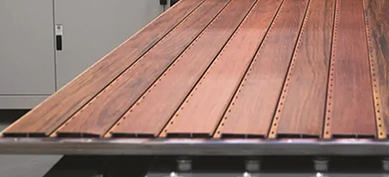Introduction: The Paramount Importance of Surface Integrity
In the world of commercial and high-end residential flooring, the battle against damage is constant. Furniture, heavy equipment, stiletto heels, and dropped objects constantly threaten the pristine surface of a floor. While aesthetics initially capture attention, long-term performance and durability ultimately define value. Among the various robust options available, architectural SPC flooring has emerged as a leading solution, distinguished by its exceptional resilience. At the heart of this performance lies a critical question: how does its unique rigid core specifically combat one of the most common forms of damage—indentation?
Understanding the Anatomy of Architectural SPC Flooring
To appreciate how the core functions, one must first understand the full structure of the product. Architectural SPC flooring is a multi-laminate engineered product, with each layer serving a distinct and vital purpose. The term SPC stands for Stone Plastic Composite (or sometimes Stone Polymer Composite), a name that hints at the core’s primary ingredients.
The standard layers, from top to bottom, are:
- Wear Layer: A clear, durable coating of urethane or similar material that is resistant to scratches, stains, and fading from UV light. The quality and thickness of this layer are measured in mils and are crucial for overall abrasion resistance.
- Decorative Layer: A high-resolution printed film that provides the aesthetic appeal, whether it be a realistic wood grain, stone texture, or abstract design. This layer is often textured using embossed-in-register (EIR) technology to align with the print, enhancing realism.
- Core Layer: The heart of the product. This is the rigid spc core, a dense composite typically made from a mixture of limestone powder (calcium carbonate), polyvinyl chloride (PVC) stabilizers, and plasticizers. This layer is responsible for the product’s structural integrity, dimensional stability, and, most importantly for our discussion, its indentation resistance.
- Underlayment/Backing Layer: Often a pre-attached foam or cork pad that provides acoustic insulation, underfoot comfort, and minor subfloor imperfection mitigation.
While all layers contribute to overall durability, the core is the primary load-bearing element. Its composition is fundamentally different from the cores found in other vinyl flooring like WPC (Wood Plastic Composite) or more flexible LVT (Luxury Vinyl Tile).
Deconstructing Indentation Resistance: A Matter of Density and Load
Indentation resistance refers to a material’s ability to resist permanent deformation when a concentrated load or impact force is applied to its surface. A failure in indentation resistance results in a permanent dent or crush mark that cannot be repaired, only replaced. This is distinct from a scratch, which affects only the surface wear layer.
The science behind this is a function of density and material composition. Softer, less dense materials have more air pockets and give way under pressure, compressing and not fully rebounding. Denser materials have tightly packed particles that distribute weight more effectively and offer greater resistance to compression. The rigid core in architectural spc flooring is engineered specifically for maximum density. The high ratio of limestone powder to PVC creates an incredibly dense and hard composite material. This density is the first and most critical line of defense against indentation.
The Material Science: Why Limestone and PVC Create an Unyielding Core
The exceptional performance of the spc core is not an accident; it is the direct result of its material composition.
- Limestone Powder (Calcium Carbonate): This is the primary filler, constituting the majority of the core’s mass. Limestone is naturally hard, dense, and dimensionally stable. In a finely ground powder form, it creates a compact, stone-like matrix. This inorganic material does not compress easily and provides the core with its signature rigidity and weight. The high limestone content is the principal reason an spc core is denser and harder than a WPC core, which uses more wood flour or other organic fillers that can be more susceptible to compression.
- Polyvinyl Chloride (PVC) and Stabilizers: The PVC acts as a binding agent, holding the limestone particles together in a solid form. The stabilizers ensure the product remains consistent in structure and performance over time, resisting expansion, contraction, and degradation from environmental factors. The specific blend of PVC and stabilizers creates a strong polymer network that encases the limestone particles, forming a unified, solid plank.
The synergy between these materials creates a composite that is far more resistant to crushing forces than any of its components could be alone. The result is a core that behaves more like a solid stone slab than a plastic-based flooring product.
Comparative Advantage: Architectural SPC vs. Other Flooring Types
The advantage of the rigid core becomes starkly evident when compared to other common flooring types. The following table illustrates key differentiators:
| Flooring Type | Core Composition | Primary Indentation Resistance Mechanism | Relative Performance |
|---|---|---|---|
| Architectural SPC | Dense Limestone Powder & PVC Composite | Extreme density and rigidity from inorganic limestone filler. | Excellent. Highly resistant to heavy, concentrated loads and point pressure. |
| WPC (Wood Plastic Composite) | Wood Plastic Composite (Wood Flour/ pulp, PVC, Foaming Agents) | Thickness and a degree of give that allows for some recovery. | Good to Very Good. Softer than SPC, more susceptible to deep, permanent dents from very heavy, narrow objects. |
| Flexible LVT | Flexible PVC | Thin, flexible vinyl. Relies on the subfloor for support. | Fair to Moderate. Highly susceptible to indentation from furniture legs and other point loads without a perfectly firm subfloor. |
| Laminate | High-Density Fiberboard (HDF) | Hardness of the resin-saturated wood fiber core. | Good, but vulnerable to moisture. HDF can swell and soften when wet, leading to permanent failure. |
| Engineered Hardwood | Plywood or HDF with a wood veneer | The hardness of the wood species used in the veneer. | Varies by species. Softer woods (e.g., pine) dent easily; harder woods (e.g., oak) perform better but are still susceptible. |
As the table demonstrates, the purely inorganic, limestone-based composition of the spc rigid core provides a distinct and measurable advantage in environments where indentation is a primary concern, such as offices, retail spaces, hospitals, and kitchens.
Beyond Material: The Role of Structural Design and Thickness
While composition is paramount, the physical design of the plank also contributes to its performance. The thickness of the core is a significant factor. A thicker spc core provides a deeper buffer against impacts, requiring more force for a object to compress the material to the point of permanent deformation. Architectural-grade spc flooring often features a thicker, heavier core than residential-grade products, signaling its enhanced load-bearing capability.
Furthermore, the rigid core acts as a monolithic unit. Unlike floors that rely on a separate subfloor for structural support, each plank of architectural spc flooring is a self-supporting, rigid tile. This means the indentation resistance is an intrinsic property of the plank itself, not dependent on the perfection of the installation substrate. While a level subfloor is always recommended for a successful installation, the core’s rigidity prevents localized flexing that would otherwise transfer point pressure into a dent.

 English
English Español
Español



